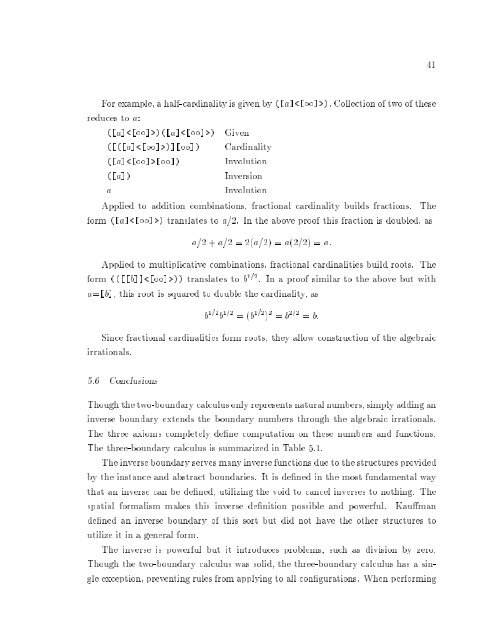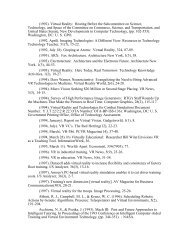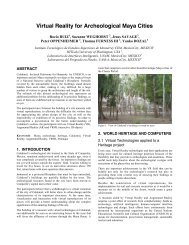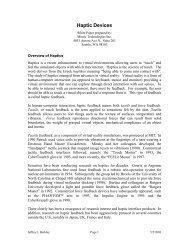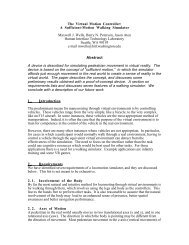A Calculus of Number Based on Spatial Forms - University of ...
A Calculus of Number Based on Spatial Forms - University of ...
A Calculus of Number Based on Spatial Forms - University of ...
You also want an ePaper? Increase the reach of your titles
YUMPU automatically turns print PDFs into web optimized ePapers that Google loves.
41<br />
For example, a half-cardinality is given by ([a]): Collecti<strong>on</strong> <str<strong>on</strong>g>of</str<strong>on</strong>g> two <str<strong>on</strong>g>of</str<strong>on</strong>g> these<br />
reduces to a:<br />
([a])([a]) Given<br />
([([a])][]) Cardinality<br />
([a][]) Involuti<strong>on</strong><br />
([a])<br />
Inversi<strong>on</strong><br />
a<br />
Involuti<strong>on</strong><br />
Applied to additi<strong>on</strong> combinati<strong>on</strong>s, fracti<strong>on</strong>al cardinality builds fracti<strong>on</strong>s. The<br />
form ([a]) translates to a=2. In the above pro<str<strong>on</strong>g>of</str<strong>on</strong>g> this fracti<strong>on</strong> is doubled, as<br />
a=2+a=2 =2(a=2) = a(2=2) = a:<br />
Applied to multiplicative combinati<strong>on</strong>s, fracti<strong>on</strong>al cardinalities build roots. The<br />
form (([[b]])) translates to b 1=2 . In a pro<str<strong>on</strong>g>of</str<strong>on</strong>g> similar to the above but with<br />
a=[b], this root is squared to double the cardinality, as<br />
b 1=2 b 1=2 =(b 1=2 ) 2 =b 2=2 =b:<br />
Since fracti<strong>on</strong>al cardinalities form roots, they allow c<strong>on</strong>structi<strong>on</strong> <str<strong>on</strong>g>of</str<strong>on</strong>g> the algebraic<br />
irrati<strong>on</strong>als.<br />
5.6 C<strong>on</strong>clusi<strong>on</strong>s<br />
Though the two-boundary calculus <strong>on</strong>ly represents natural numbers, simply adding an<br />
inverse boundary extends the boundary numbers through the algebraic irrati<strong>on</strong>als.<br />
The three axioms completely dene computati<strong>on</strong> <strong>on</strong> these numbers and functi<strong>on</strong>s.<br />
The three-boundary calculus is summarized in Table 5.1.<br />
The inverse boundary serves manyinverse functi<strong>on</strong>s due to the structures provided<br />
by the instance and abstract boundaries. It is dened in the most fundamental way<br />
that an inverse can be dened, utilizing the void to cancel inverses to nothing. The<br />
spatial formalism makes this inverse deniti<strong>on</strong> possible and powerful. Kauman<br />
dened an inverse boundary <str<strong>on</strong>g>of</str<strong>on</strong>g> this sort but did not have the other structures to<br />
utilize it in a general form.<br />
The inverse is powerful but it introduces problems, such as divisi<strong>on</strong> by zero.<br />
Though the two-boundary calculus was solid, the three-boundary calculus has a single<br />
excepti<strong>on</strong>, preventing rules from applying to all c<strong>on</strong>gurati<strong>on</strong>s. When performing


